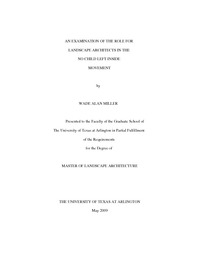
ATTENTION: The works hosted here are being migrated to a new repository that will consolidate resources, improve discoverability, and better show UTA's research impact on the global community. We will update authors as the migration progresses. Please see MavMatrix for more information.
Show simple item record
| dc.contributor.author | Miller, Wade | en_US |
| dc.date.accessioned | 2009-09-16T18:16:45Z | |
| dc.date.available | 2009-09-16T18:16:45Z | |
| dc.date.issued | 2009-09-16T18:16:45Z | |
| dc.date.submitted | January 2009 | en_US |
| dc.identifier.other | DISS-10193 | en_US |
| dc.identifier.uri | http://hdl.handle.net/10106/1647 | |
| dc.description.abstract | The disconnection, or lack of interaction and experience, between children and nature has been coined Nature Deficit Disorder and popularized by Louv (Louv 2005, pp. 139-140). Current research and writing regarding the child and nature disconnect has spawned the No Child Left Inside movement. This movement is an initiative being adopted by cities, states, federal agencies and other organizations committed to reconnecting children with nature by providing a wide range of opportunities to experience nature directly, while building the next generation of environmentally conscious citizens.This research examines how landscape architecture is viewed by those associated with Children and Nature Network (C&NN), the primary organization formed to encourage and support other organizations that are active in this movement. Leaders of this organization include published authors, educators, entrepreneurs, researchers, academics, youth leaders, and business and organizational leaders. Through C&NN, these professionals are the leading proponents of the No Child Left Inside movement. While some of the research and literature mentions specific areas such as open space planning, park design, school design, and playground design; the landscape architect is not recognized as a central figure in the movement to reconnect children and nature.The hypothesis of this research is that the field of landscape architecture is uniquely qualified and positioned to address this topic through open space frameworks, urban planning, urban design, park design, schoolyard design, residential design, and children's gardens. In this study, open-ended interviews of researchers, authors, and supporters associated with C&NN are used to identify the perceptions of the role that landscape architects play in reconnecting nature and children. These selected professionals share their perceptions based on their knowledge and experience in this area. The findings show that there is much opportunity for landscape architects to influence the realization of nature and children reconnected. | en_US |
| dc.description.sponsorship | Taylor, Pat D. | en_US |
| dc.language.iso | EN | en_US |
| dc.publisher | Landscape Architecture | en_US |
| dc.title | An Examination Of The Role For Landscape Architects In The No Child Left Inside Movement | en_US |
| dc.type | M.L.A. | en_US |
| dc.contributor.committeeChair | Taylor, Pat D. | en_US |
| dc.degree.department | Landscape Architecture | en_US |
| dc.degree.discipline | Landscape Architecture | en_US |
| dc.degree.grantor | University of Texas at Arlington | en_US |
| dc.degree.level | masters | en_US |
| dc.degree.name | M.L.A. | en_US |
| dc.identifier.externalLink | https://www.uta.edu/ra/real/editprofile.php?onlyview=1&pid=1152 | |
| dc.identifier.externalLinkDescription | Link to Research Profiles | |
Files in this item
- Name:
- Miller_uta_2502M_10193.pdf
- Size:
- 186.6Kb
- Format:
- PDF
This item appears in the following Collection(s)
Show simple item record


